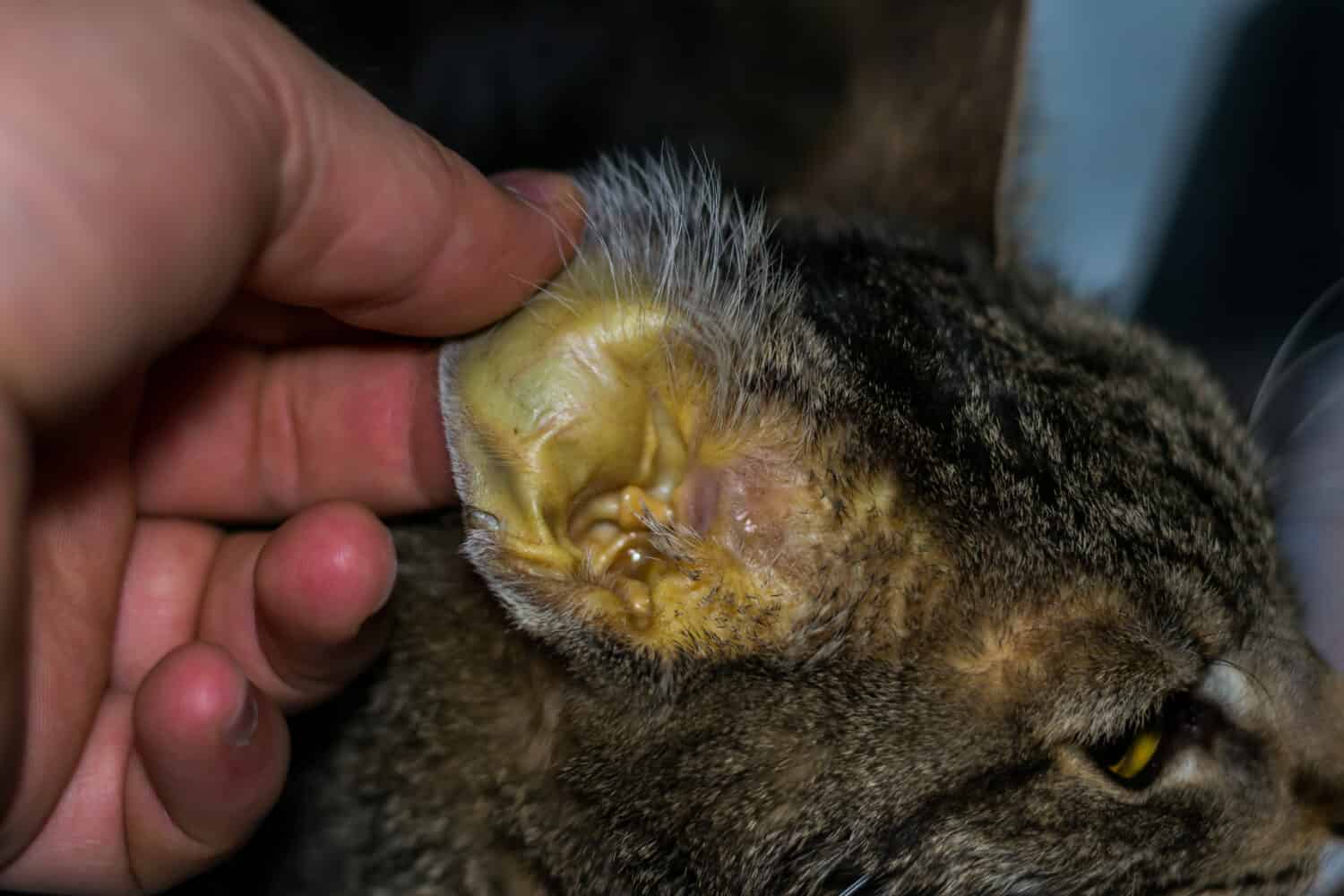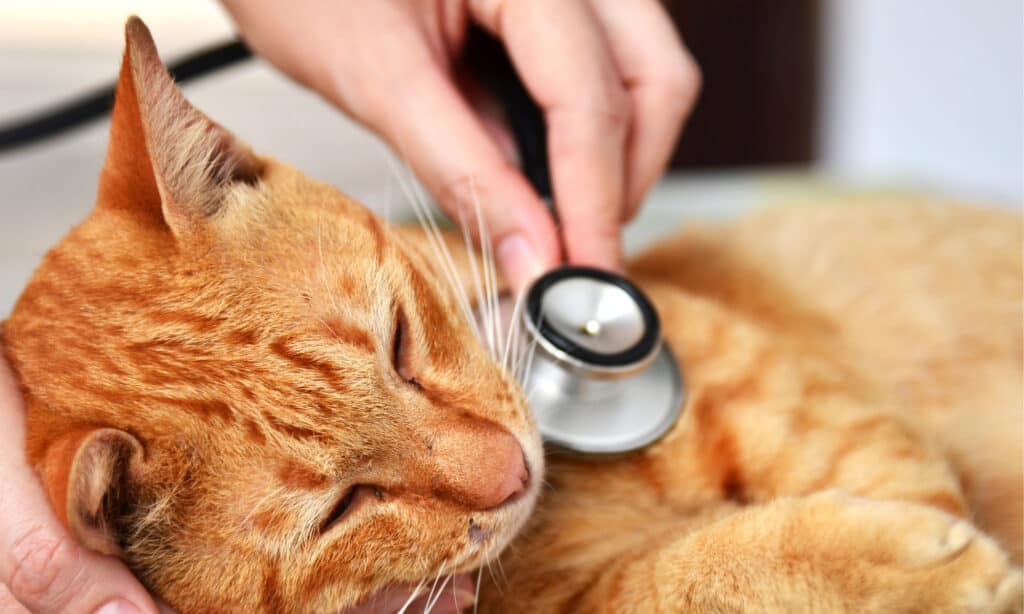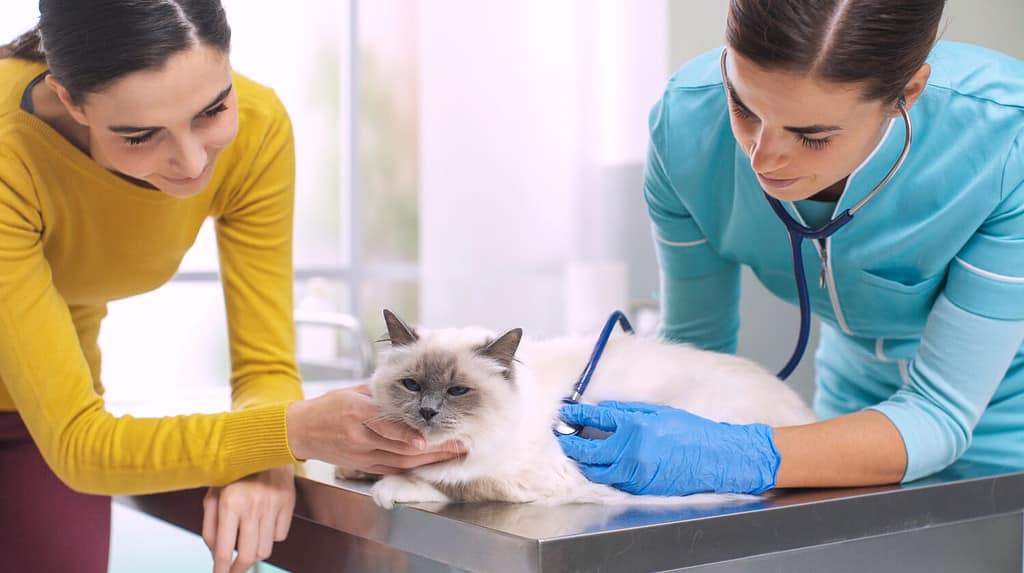
Cats should only receive medication, including azithromycin, as prescribed by a veterinarian.
©Pressmaster/Shutterstock.com
Sometimes, our feline friends need medication. A powerful macrolide antibiotic, azithromycin treats both humans and animals. AZ Animals spoke with Dr. Shelly Wyatt, Doctor of Veterinary Medicine at Northwood Hills Animal Hospital in Gulfport, MS, regarding the use of azithromycin in cats. Where safety is concerned, she said azithromycin is “technically safe for [cats of] all ages, but this is considered a ‘big gun’ antibiotic, so should only be reached for when specific diseases like Bartonella, Mycoplasma, Cytauxzoon, or Crytosporosis are present, or if more conservative treatments have failed.”
With this information in hand, we remind anyone reading this article that giving medication of any kind to your pet requires a veterinarian’s advice and direction. This article does not replace veterinary advice. Failure to consult a veterinarian before giving medication to your cat could result in major side effects up to and including death.
What is Azithromycin Used for in Cats?

Jaundice (or icterus) is a term that refers to the yellowing of the skin and mucous membranes. It may also affect the sclera (white part of the eye).
©Todorean-Gabriel/Shutterstock.com
As Dr. Wyatt pointed out, azithromycin is usually prescribed for specific diseases when other treatments have failed. An important note regarding azithromycin is that the FDA has not approved its use in cats. Therefore, while it is legal for your veterinarian to give this to your cat, they will be using it off-label. One study determined that azithromycin was ineffective in treating feline clamydophilosis infections in cats. This bacterial infection generally affects the mucous membranes, such as the conjunctiva (pink tissue that surrounds the eye) and the lining of the nose. So, what infections does azithromycin treat?
Bartonella
Transmitted through the bites of fleas, body lice, and sand flies, this infection appears in outdoor cats often. Humans catch it through cat scratches. Aptly called “cat scratch fever” by some, this condition is zoonotic. That means people can catch it from animals. Signs of Bartonella infection include fever, vomiting, tiredness, red eyes, swollen lymph nodes, and not wanting to eat. Cats can also become infected through contact with infected blood either in cat fights or through a blood transfusion. Treatment with azithromycin is not usually the first choice in cats with Bartonella. If the disease becomes resistant to the medication, it is resistant to all macrolide antibiotics in turn. Other macrolide antibiotics available for use in the U.S. include clarithromycin, erythromycin, fidaxomicin, and telithromycin.
Mycoplasma
Formally called feline hemotrophic mycoplasma (FHM), this rare condition in cats causes anemia. That’s because the red blood cells become infected with the bacterial parasite, and the body begins to kill them off since they are no longer recognizable. Signs of the infection may not be apparent until the cat is very ill. However, symptoms may include pale gums and jaundice (a yellow tinge to the skin or mucous membranes). Jaundice (also called icterus) is the result of damage to the liver. Veterinarians only choose treatment with azithromycin in cats for this condition when other treatments don’t work. Typical drugs used include a broad-spectrum antibiotic such as doxycycline, enrofloxacin, or marbofloxacin. As another zoonotic infection, humans treating cats with this disease should practice good hygiene after handling the cat. This includes washing their hands every time they touch or medicate the cat.
Cytauxzoon
This tick-borne disease also infects blood cells in cats. Originally found in bobcats, this disease infects many species of both wild and domestic felines. Usually, the Lone Star tick or the American dog tick passes this infection through their bite. Thankfully, cats do not directly pass it to one another. Generally, signs develop about 10 days after the bite, and onset is rapid. Symptoms include low body temperature, seizures, and coma. If left without treatment, the cat will likely die. However, one study discussed the possibility that multiple strains of the disease exist because some domestic cats survive the infection. Azithromycin, along with antiprotozoal drugs such as imidocarb or atovaquone, helps cats heal from this condition. Lastly, this disease cannot be transmitted to humans.
Crytosporosis
Marked by severe diarrhea, this intestinal parasite passes from cat to cat through infected fecal matter. Because cats lick themselves to get clean, they can ingest this parasite easily. Oftentimes, cats catch this disease through mutual grooming, shared litter boxes, or contaminated food or water. No medication proves effective in killing this parasite all the time. The main goal of treatment is to cure diarrhea. However, some veterinarians use azithromycin in very ill cats. Unfortunately, this disease is also zoonotic.
Side Effects of Azithromycin in Cats

It’s important to take your cat to the vet if you witness vomiting, diarrhea, decreased appetite, and other side effects of azithromycin.
©iStock.com/Jeng_Niamwhan
The use of any medication comes with the risk of side effects. Cats that have previously had a reaction to a macrolide antibiotic should not take azithromycin. The dosage, duration, and treatment frequency vary based on the condition, how one responds to the medication, and the event of adverse effects. Again, your veterinarian will determine the proper usage of azithromycin for your cat.
Possible side effects to watch for include:
- Vomiting
- Diarrhea
- Abdominal pain
- Decreased appetite
- Heart arrhythmia
- Renal (kidney) dysfunction – watch for increased drinking and urination, lethargy
- Hepatic (liver) dysfunction – watch for jaundice, lethargy, pale gums
- Eye irritation (when used as an eye drop)
If your cat is taking azithromycin and you notice any of these side effects, contact your veterinarian immediately. Also, contact your veterinarian if you become concerned about anything while your cat is taking this medication. It’s better to be safe than sorry!
When Should Cats Not Take Azithromycin?

Make sure your vet knows every medication your cat is on if they prescribe azithromycin.
©Stock-Asso/Shutterstock.com
Cats with diagnosed liver or kidney disease should not take azithromycin. Make sure the veterinarian recommending azithromycin is fully aware of any and all medication, vitamins, and supplements your cat is taking.
Medications that interact with azithromycin include:
- Digoxin, theophylline, cyclosporine, and methylprednisolone: Combining these with azithromycin may increase the blood serum levels of these medications. That means the concentration of the drug in the blood is higher than intended, which can produce side effects, including death. This is particularly true for theophylline, as there is already a risk for toxic effects when used in cats.
- Triazolam and midazolam: These medications may take longer to clear the body when given with azithromycin in cats. Sometimes used in anesthetic procedures, cats given these medications, when they are already taking azithromycin, may take longer to wake up from surgery. This increases the likelihood of problems associated with anesthesia, such as low body temperature. While low body temperature seems minor, it is actually the number one cause of death in cats after surgery.
- Cisapride, ondansetron, doesetron, sotalol, quinilone antibiotics, and antifungal medications in the “azole” family (ketoconazole, metronidazole, etc.): Concurrent administration of these medications can increase the chances of heart rhythm disturbance (arrhythmia). If this cannot be corrected, the cat may die.
- Oral antacids (omeprazole, famotidine, etc.): These medications can block the absorption of azithromycin in cats and reduce its effectiveness. If your cat takes any of these medications, give them at least two hours before or after azithromycin.
- Phenobarbital: This seizure medication also affects the cat’s ability to process and use azithromycin. So, using them together may make the antibiotic less effective.
Dosage Chart for Azithromycin in Cats

Follow your vet’s instructions on the proper azithromycin dosage for your cat.
©iStock.com/Valery Kudryavtsev
Azithromycin comes in many dosage forms, and your veterinarian can help you choose the right one for your cat. Typically, it is available in tablets, capsules, injections, oral suspensions, and eye drops. Sometimes, compounding pharmacies can make special formulations, such as ear ointments that allow the medication to absorb through the skin. The usual dose for azithromycin in cats is 2.5–7.5 mg per pound of body weight every 12–24 hours for up to seven days. Your veterinarian may want you to use a tapering dose which means gradually decreasing how often you give the medication over a set period of time.
Always follow your veterinarian’s instructions exactly and finish the prescribed course unless otherwise instructed, even if your cat appears to be feeling 100% better.
| Cat’s Weight in Pounds | Azithromycin Dosage | Cat Breeds Include |
|---|---|---|
| 0-5 | 2.5-37.5 mg per dose | Singapura, Bambino |
| 6-10 | 15-75 mg per dose | Siamese, Cornish Rex |
| 11-20 | 27.5-150 mg per dose | Bengal, Ragdoll |
| Over 20 | consult your vet | Maine Coon, Savannah |
The photo featured at the top of this post is © iStock.com/Valery Kudryavtsev
Thank you for reading! Have some feedback for us? Contact the AZ Animals editorial team.







